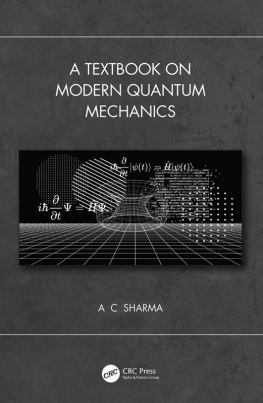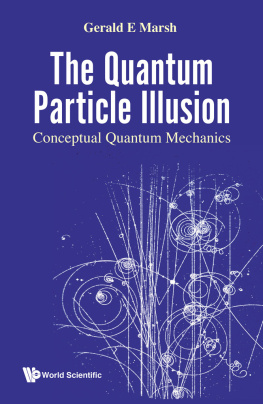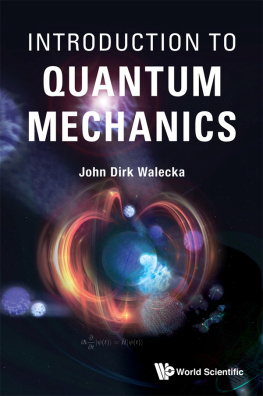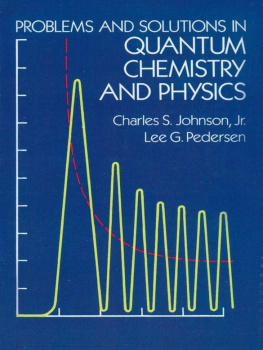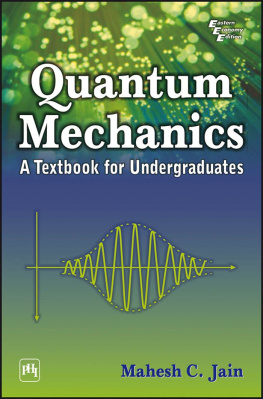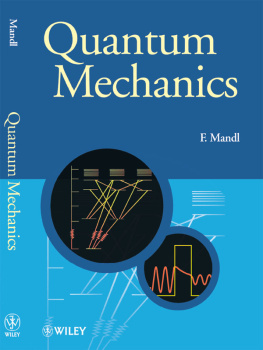Exploring Quantum Mechanics
Exploring Quantum Mechanics
A Collection of 700+ Solved Problems
for
Students, Lecturers, and Researchers
Victor Galitski, Boris Karnakov, Vladimir Kogan, and Victor Galitski, Jr.


Great Clarendon Street, Oxford, OX2 6DP,
United Kingdom
Oxford University Press is a department of the University of Oxford.
If furthers the Universitys objective of excellence in research, scholarship,
and education by publishing worldwide. Oxford is a registered trade mark of
Oxford University Press in the UK and in certain other countries
V. Galitski, B. Karnakov, V. Kogan, and V. Galitski, Jr. 2013
The moral rights of the authors have been asserted
First Edition published in 2013
Impression: 1
All rights reserved. No part of this publication may be reproduced, stored in
a retrieval system, or transmitted, in any form or by any means, without the
prior permission in writing of Oxford University Press, or as expressly permitted
by law, by licence or under terms agreed with the appropriate reprographics
rights organization. Enquiries concerning reproduction outside the scope of the
above should be sent to the Rights Department, Oxford University Press, at the
address above
You must not circulate this work in any other form
and you must impose this same condition on any acquirer
British Library Cataloguing in Publication Data
Data available
ISBN 9780199232710 (Hbk.)
ISBN 9780199232727 (Pbk.)
Printed and bound in Great Britain by
CPI Group (UK) Ltd, Croydon, CR0 4YY
Preface to the first English edition
The book you are now reading contains arguably the worlds largest collection of problems in quantum physics, which span just about the full scope of subjects in quantum theory ranging from elementary single-particle quantum mechanics in one dimension to relativistic field theory and advanced aspects of nuclear physics. There are more than 700 problems of various difficulty, accompanied by detailed solutions. While some problems are elementary and may be accessible to advanced undergraduate students, some are at the research level that would be of challenge and interest to a practicing theoretical physicist. Consequently, the book will be useful to a wide range of readers including both students studying quantum mechanics and professors teaching it. In fact, this problem book has a proven record of being a scientific bestseller in other countries, notably in Russia, where its earlier versions have been used for over thirty years as a standard text to learn and teach quantum physics at all leading universities.
Even though this is the first English edition of the book, several editions in the Russian, French, and Japanese languages have been available since 1981 (a much smaller collection of elementary problems by Victor Galitski, Sr. and Vladimir Kogan was first published in 1956 and is available in English too). Following the fine tradition of Russian theoretical physics, this book of problems has usually been used in conjunction with the legendary Landau and Lifshitz theoretical physics course. However, the latter is certainly not the only option for a basic supporting text, and many other excellent textbooks are now available. Therefore, I do not reiterate here the strong recommendation of the first Russian edition, and suggest instead that a choice of the supporting quantum textbook be left to the reader or professor teaching a course. Furthermore, each chapter of this book begins with a concise summary of the underlying physics and main equations, which makes the book almost self-contained. Therefore, for a student or researcher, who has had even minimal exposure to quantum mechanics, it may become a useful and rich independent resource to master the field and develop actual problem-solving skills.
Let me also emphasize two points about the text. The first is that the level of mathematical abstraction here is generally pretty low (with the exception of the first chapter perhaps) not due to a lack of expertise by the original authors, but because their target audience has been practicing physicists interested in understanding and solving real-life problems. Consequently, if your motivation for doing or studying quantum physics is to understand actual phenomena and explain experiments, this book will certainly be useful. For example, the chapters on nuclear physics contain a large number of problems that are directed to quantitative explanation of specific experimental data. The second warning is that the terminology may be somewhat outdated at times, and no references to modern literature are provided. I intentionally decided to preserve the integrity of the book (a number of new problems that are included here compared to the earlier editions have been incorporated into the old structure of chapters). Because I believe that the old-school style of the book is not at all a downside.
Quite on the contrary, we can certainly learn a lot from people who worked in the good old days of theoretical physics. These were people living and working in completely different times, and they were quite different from us, todays scientists: with their attention spans undiminished by constant exposure to email, internet, and television, and their minds free of petty worries about citation counts, indices, and rankings, they were able to devote 100% of their attention to science and take the time to focus on difficult problems that really mattered, making a difference on an absolute scale. We are now standing on their shoulders, and in fact most quantum phenomena that we are fascinated with today go back to their accomplishments in decades past.
With this in mind, I would like to say a few words about the rather fascinating history of this book and the original authors, particularly about the lead author Victor Galitski, Sr. who was the main driving force behind the book and who conceived most of the problems you will find here. Even though I admittedly cannot be completely unbiased in talking about him (he was my late grandfather), I can say with confidence that apart from being a first-rate teacher and educator, he was also a giant of theoretical physics and an amazingly creative scientist. His contributions to quantum physics are manifold, and include the first use of Feynman diagrams in solid-state physics, the first microscopic derivation of Landaus Fermi liquid theory, various fundamental results in nuclear physics (e.g., GalitskiiFeynman equations), the first theory of unconventional superconductivity and many other famous results. He co-authored papers with such luminaries as Lev Landau and Arkady Migdal, and trained a generation of theoretical physicists (my own late adviser, the great Anatoly Larkin, among them).
The sheer amount of work by Galitski, Sr. is very impressive in and by itself, but it is even more so considering his very short and difficult life and his short career as a physicist. I hope the reader will excuse my mentioning it briefly in the following couple of pages. Victor Galitski, Sr. was born in 1924 in Moscow. In 1942, shortly after graduating from high school, he enlisted in the army, having married my grandmother, Tatiana, just a few days before his leaving. (They did not know if they would see each other again. Fortunately they did, and she was his devoted wife for almost forty years.) He was sent to the front shortly after, and eventually became a commander of an artillery unit. In 1943 he was severely wounded during the Battle of Kursk. He hardly survived, and spent over a year in a hospital. After being honorably discharged from the army, he entered the Moscow Mechanical Institute of War Ammunition (which later was renamed the Moscow Engineering Physics Institute, MEPhI, and where years later in 1960 he became Head of the Theoretical Nuclear Physics Department). While studying at MEPhI he discovered his gift and interest in theoretical physics, and after graduating in 1949 he joined the theory group led by Arkady Migdal at the Institute of Atomic Energy in Moscow.
Next page

